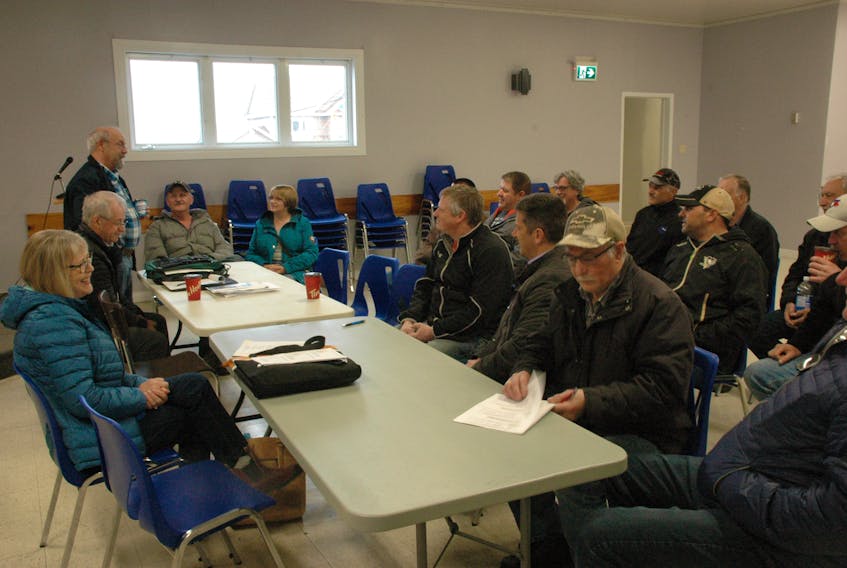ST. ANTHONY, N.L. – Retention salmon anglers on the Great Northern Peninsula are concerned they may be losing a way of life.
The Citizens Outdoors Rights Alliance (CORA) hosted a meeting with local anglers at the St. Anthony Lions Club on Wednesday evening, June 13.
The session ran for over two hours, as various concerns were raised related to the federal government’s management of the salmon fishery.
Mainly, anglers are concerned about the future of retention angling in Newfoundland and Labrador.
In May, the Department of Fisheries and Oceans’ (DFO) salmon management plan included a large cut in the number of fish retention anglers can take.
DFO decided the season will start with one fish retention on all rivers in the province that currently allow retention. That tag will be valid from one before sunrise June 1 until one hour after sunset on July 20.
An in-season review of returns will be conducted and the results of that will inform the management approach for the rest of the season.
Catch-and-release limits have been reduced to three fish per day and retention of salmon on non-scheduled waters is not permitted.
Ward Samson, a salmon angler from Main Brook, opened the meeting with an impassioned speech on his love for the activity.
To him, it’s a way of life and an important part of the local culture.
Samson said he catches salmon to eat. But he’s worried that come the July review, anglers like himself won’t be able to retain anymore.
Fairness
CORA president Gary Gale led much of the session. He stressed the need for “fairness and balance” in DFO’s plan for retention and catch-and-release angling.
According to data provided by DFO, the mortality rate for catch-and-release salmon is 10 per cent. This means, for every 10 salmon caught and released back into the river, one will die.
Therefore, Gale believes if retention anglers are only able to kill one salmon, the same should be true for catch-and-release anglers.
In other words, based on DFO’s data, catch-and-release anglers should only be allowed to release 10 salmon in total for the same period that retention anglers are only allowed to keep one.
Currently, they can catch-and-release three per day.
Bad science?
But Gale, and anglers in attendance, also question the science behind DFO’s data. Many believe the mortality rate for catch-and-release salmon may, in fact, be higher than 10 per cent.
CORA and anglers are concerned that DFO does not factor in water temperature, the size of rivers and how people handle the salmon.
Many people, for example, take the salmon out of the water and get a picture taken with it. But Gale says it’s CORA’s belief that the salmon should never be taken out of the water before it’s released.
Some in attendance pointed out that catch-and-release anglers sometimes handle the fish with gloves. They say this is a big no-no, as it removes the slime from the fish, decreasing its chances for survival.
CORA believes better education is needed on how to properly catch-and-release a salmon.
Another question was raised over the length of time the salmon had to survive in DFO’s study – whether, for instance, it survived at the time of hook and release, or a week later, or to the end of the season. Furthermore, it was asked whether they could make it to spawn the same as a salmon that was never hooked.
According to DFO’s 2002 research on the effects of catch-and-release angling on Atlantic salmon on the Conne River, three salmon died “within four hours of being caught, and one a week later.”
The study did not say anything on the salmon’s comparative ability to spawn after being hooked.
CORA supports the Department of Fisheries and Land Resources plans to conduct an updated two-year study on the fate of salmon caught and released.
Privatization
For Gale and some of the anglers in attendance, privatization of the salmon fishery is a major concern.
“We know on some of our rivers runs are really good, yet groups advocate hook and release only, so why would they want to do that?” Gale asked, in conversation with The Northern Pen following the meeting.
He believes outfitters want to take advantage of a perceived business opportunity.
They know the wealthy are willing to pay dearly for the rights to catch-and-release fish on these rivers.
“That’s the way it is the UK, that’s the way it is in New Brunswick, the rivers are privately owned,” he said. “God help us if that ever happens in Newfoundland.”
That means that many local retention anglers, who Gale says make up about 95 per cent of anglers in the province, would no longer be able to afford to fish on the rivers.
“It seems to me that they’re catering to a small minority who want exclusive access to pools,” he said.
Gale says in the late-1990s there was a movement in Newfoundland and Labrador to privatize, but anglers protested and the government backed off on the plan.
Sub-committee
Near the end of the meeting, anglers in attendance appointed six members for a local CORA sub-committee. Curtis Richards, Darl Scott, Cory Simms, Jeff Slade, Steve Sheppard and Glenn Roberts agreed to join the committee.
A chairperson was not elected at that time.
Gale says CORA has been setting up sub-committees in different regions across the province.
This is to help facilitate better communication with the membership in those regions.
What is CORA?
Per its website, the Citizens Outdoors Rights Alliance is a “coalition of anglers, business groups, conservation groups and agencies interested in the preservation and protection of Newfoundland and Labrador resources for the benefit of all groups interested in recreational fishing, along with the protection of cultural and historic access to resources.”
[email protected]
With files from The Telegram









